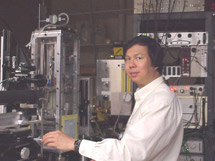
Handy Links
SLAC News Center
SLAC Today
- Subscribe
- Archives: Feb 2006-May 20, 2011
- Archives: May 23, 2011 and later
- Submit Feedback or Story Ideas
- About SLAC Today
SLAC News
Lab News
- Interactions
- Lightsources.org
- ILC NewsLine
- Int'l Science Grid This Week
- Fermilab Today
- Berkeley Lab News
- @brookhaven TODAY
- DOE Pulse
- CERN Courier
- DESY inForm
- US / LHC
SLAC Links
- Emergency
- Safety
- Policy Repository
- Site Entry Form

- Site Maps
- M & O Review
- Computing Status & Calendar
- SLAC Colloquium
- SLACspeak
- SLACspace
- SLAC Logo
- Café Menu
- Flea Market
- Web E-mail
- Marguerite Shuttle
- Discount Commuter Passes
-
Award Reporting Form
- SPIRES
- SciDoc
- Activity Groups
- Library
Stanford
Around the Bay
Eric Lee: Searching for Fractional Electric Charge and Studying Dark Matter
 Eric Lee—inventor, electronic engineer, expert computer user, machinist, amateur astronomer, graduate student mentor—joined SLAC's Group E in 1994 after a dozen years working on novel cancer therapies in the Stanford Medical School. Since then, he has worked on a variety of projects including the search for particles with fractional electric charge and the development of the very large CCD camera for the Large Synoptic Survey Telescope (LSST).
Eric Lee—inventor, electronic engineer, expert computer user, machinist, amateur astronomer, graduate student mentor—joined SLAC's Group E in 1994 after a dozen years working on novel cancer therapies in the Stanford Medical School. Since then, he has worked on a variety of projects including the search for particles with fractional electric charge and the development of the very large CCD camera for the Large Synoptic Survey Telescope (LSST).
All known free elementary particles such as neutrinos, photons, muons and taus have an electric charge of either zero or ± q. The one exception to this is the quark, which has a charge of ±2/3q or ±1/3q. Yet because quarks are always bound in nucleons or mesons, the observed charge is either zero or ±q. For the past 100 years, physicists have been looking without success for free particles with fractional electric charge using accelerators, colliders, searches in cosmic rays and searches in ordinary matter. Several modern particle physics theories predict the existence of just such particles, and we do not know of any fundamental reason why particles with fractional electric charge do not exist. Yet they have never been observed.
In science, the final test of theories and ideas is observation and experiment. With this in mind, Lee joined with Martin Perl to search for fractional charge using a modern version of the Millikan Oil Drop method. Lee's experiments use liquid drops about 20 microns in diameter—about one fifth the diameter of a human hair. These drops are allowed to fall vertically through the air while an oscillating electric field moves the drops back and forth horizontally. The drop trajectory is recorded in real time by a CCD camera and analyzed by a computer system, to measure the drop's charge with a precision of about one twentieth of an electron charge.
Over the past 12 years, the sensitivity and range of the searches has steadily improved through the work of Lee and three Stanford graduate students who received their PhDs working with Lee. The earlier phase of the experiment published results on the largest amount of terrestrial material ever studied. The present search—which has been going on for almost three years—involves exotic asteroidal material obtained from the Allende meteorite that fell in Mexico in 1969. Lee has almost fully automated the experiment so that it requires his intervention only a day or so every two weeks, which he does between checking and analyzing the data as it comes in. While no fractional charge particles have yet been found, Lee and Perl would like the current search to continue until the apparatus can no longer be repaired or maintained.
Another application of Lee's work is perhaps the most unexpected: ink jet printers. The drops used in the apparatus are roughly the same size as those used in ink jet printers, making Lee and his "drop generator" well-known in the world of microdrop generator technology. He has consulted with, and provided instruction to, many users and potential users of microdrop technology in biology, medicine and physics. He is the author of "Microdrop Generation," published by CRC Press—the first book published on applying inkjet microdrop techniques to scientific research. Because Lee's laboratory provides open information on drop generation as part of SLAC's mission for the Department of Energy, his work is particularly useful for non-standard users of microdrop technology in this era of highly competitive and secretive computer printer companies.
Lee now devotes any extra time to developing and testing prototype components for the LSST camera. The LSST, a joint collaboration between SLAC and a number of other laboratories and universities across the United States and Europe, is designed to carry out the most penetrating and inclusive study of the dark matter in the universe. Lee has developed a system using commercial integrated circuits to monitor—at the tenth of micron level—the dimensional stability of the precise mechanical structures that support the camera's three billion pixel CCD array that makes up the focal plane.
—Martin Perl, March 14, 2007
Above image: Eric Lee in front of his fractional charge search apparatus. (Click on image for larger version.)